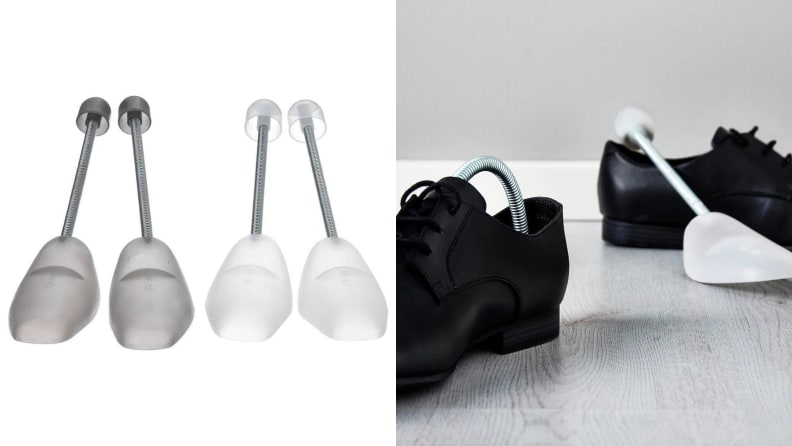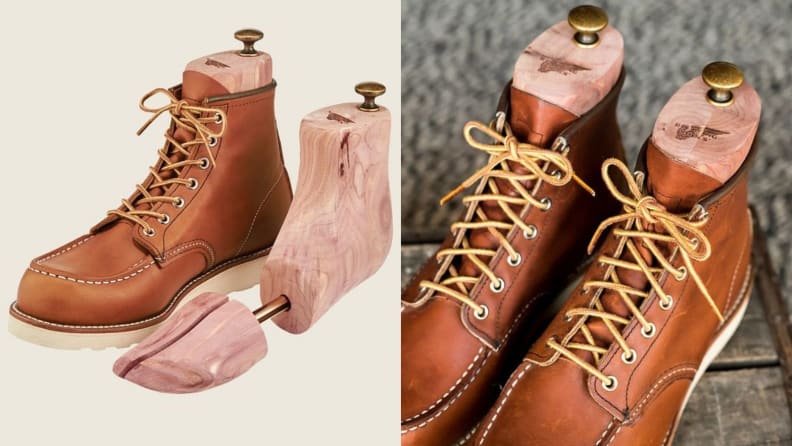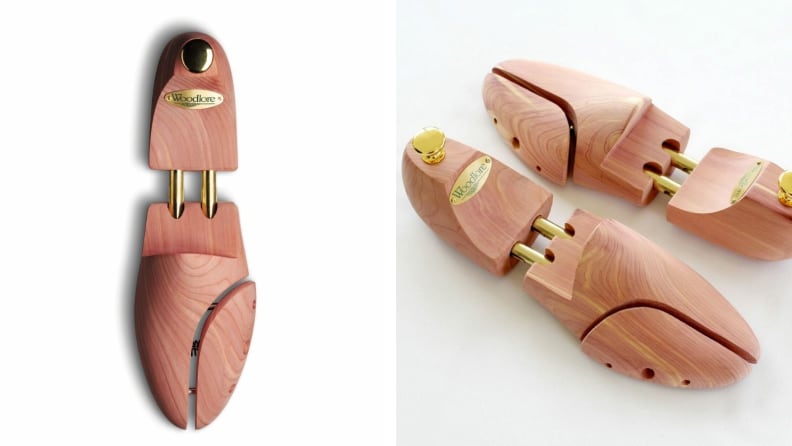Why you should use shoe trees if you aren’t already
These inexpensive devices will prolong the life of your footwear.
Products are chosen independently by our editors. Purchases made through our links may earn us a commission.
If you’ve ever splurged on a pricey pair of shoes, you know that caring for them is of the utmost importance. Regardless of quality, that footwear is an investment—a piece of your ensemble that should serve your feet well for years to come. Cleaning them is one stage of the care process, while being mindful of where you step is another. But what happens when they start to lose their shape or begin to reek?
This is where shoe trees come in—an essential device that helps upkeep your footwear. These spring-loaded tools are vital to keeping your shoes looking in pristine condition, whether they’re sneakers, dressy oxfords, penny loafers, or even boots. (Some can also deodorize!) Here’s everything you need to know about shoe trees, including how to use them.
What is a shoe tree?
A shoe tree is a foot-shaped gadget that fits inside of a shoe and helps preserve its shape when not in use, thus extending its life. Whether plastic or wood, a pair of shoe trees will help prevent shoes from creasing over time. They’ll also aid in smoothing out existing creases that have formed on the upper and toe box through use.
A shoe tree achieves this with its spring—it pushes the forefoot of the device out toward the front of a shoe, flattening creases from the inside. By tucking in a pair of shoe trees into your footwear between uses, you can prevent and hinder the formation of new creases. The snugger the tree fits, the better the de-wrinkling effect. This also helps with maintaining the shape and figure of a shoe.
Similar to a shoe stretcher—but without the same range—shoe trees can also help break in tough leather footwear. The length of the shoe gets pushed out from the forefoot and heel, causing the shoe to appear oval in shape as light pressure stretches the shoe from the inside. This helps with loosening up tough leather heels and widening narrow toe boxes.
Shoe trees come in sizes XS to XL that can suit shoes within a full-size-and-a-half range. For example, a size large in men’s shoe trees can adjust between men’s shoe sizes 10 to 11.5.
What do you use plastic shoe trees for?

Plastic shoe trees are inexpensive and are usually sold in multi-packs.
If you have sneakers, or if you just want something to help your shoes maintain their shape, a pair of plastic shoe trees will get the job done. These have a solid forefoot and a small nub at the heel of the device. Most are widely adjustable and are able to handle a larger range of sizes than wooden shoe trees. Plastic shoe trees, however, do not help with odor or absorbing moisture. You can buy them in bundles as well as pairs, and they can cost as little as $4 per twosome.
- Get the Yoloplus+ 2-Pair Pack of Plastic Shoe Trees from Amazon for $9.59
- Get the Ambram 5-Pair Pack of Unisex Plastic Shoe Trees from Amazon for $15.99
What do you use wooden shoe trees for?
A wooden shoe tree is a step up from plastic—and thus more expensive—as it’s sturdier and less likely to break. Many wooden shoe trees are made from cedarwood, but some are made from pine or imitation mahogany. Non-cedar wooden shoe trees are fine for keeping shape and better quality than plastic, but lack the freshening qualities of cedar (though they cost less).
- Get the Cedar Elements 2-Pair Pack of Cedarwood Women's Sized Shoe Trees from Amazon for $20.85
- Get the Cedar Elements 6-Pair Pack of Pine Wood Men’s Sized Shoe Tree from Amazon for $39
What are the benefits of cedarwood shoe trees?
Sweat build-up is a common side effect of wearing closed-toe shoes, where feet can’t breathe and socks exacerbate moisture. Wearing the same pair of shoes daily, or not allowing them to air out in between uses, can cause stinky footwear and promote bacterial growth leading to mold and mildew.
This is where cedarwood shoe trees come in. Cedarwood is naturally absorbent and antimicrobial. It pulls in moisture—a.k.a. foot sweat—and helps dry out shoes, as well as ward off odor-causing bacteria. The cedarwood also has a natural fresh scent, which can make shoes smell better between wears.
Using cedarwood is most important for preserving leather shoes. Leather is vulnerable to moisture and water damage, and excess dampness will break down the shoes’ hide, causing it to crack, wrinkle, and permanently distort its shape or even rot. To help maintain the integrity of leather shoes—whether it’s full or corrected grain—cedarwood shoe trees absorbs moisture and helps them dry faster, which makes your leather last longer.
Unlike the cheaper options on this list, most cedarwood shoe trees have a fully shaped heel instead of a nub, making for better structural support. They can last a lifetime if properly cared for, but cedar needs an annual light sanding to refresh its cedar aroma.
- Get the Cedar Elements 6-Pack of Women’s Sized Wooden Shoe Trees from Amazon for $48
- Get the Woodlore 2-Pair Pack of Women’s Sized Cedarwood Shoe Trees from Amazon for $36.98
What’s a boot tree?

Boot trees have a unique shape to help hold the structure of a boot's collar.
Also known as boot shapers, boot shoe trees have a tall heel that helps keep the shape of a boot collar and prevents it from slumping over. As with shoe trees, you'll get better quality and shoe preservation from wooden boot trees (especially those made of cedar), but you can get cheaper options made of plastic, which solely keep the boots' collars upright. The same pricing tiers hold here, too, with plastic being least expensive and cedar being most, on average.
- Get the Whitmore Adjustable Boot Shape in Men’s and Women’s Sizes from Amazon for $8.17
- Get the Stratton Boss Cedarwood Boot Tree in Men’s Sizes from Amazon for $49.99
How to use shoe trees

Using shoe trees is a simple endeavor.
Shoe trees come in pairs—one for the left foot, one for the right. Place the forefoot of the device inside of the corresponding shoe and push it inside. The spring, which is usually located in the shoe tree’s heel, will create tension to ensure a tight fit. Once the shoe tree is fully inside the shoe, push down on the heel to make sure it’s resting on the insole. (If your shoe tree has a small nub, which points directly outward, you can skip this step as it's not adjustable.) You can leave them in your shoes for as long as you’d like—just remember to put them back in after you take your shoes out for a night on the town.
